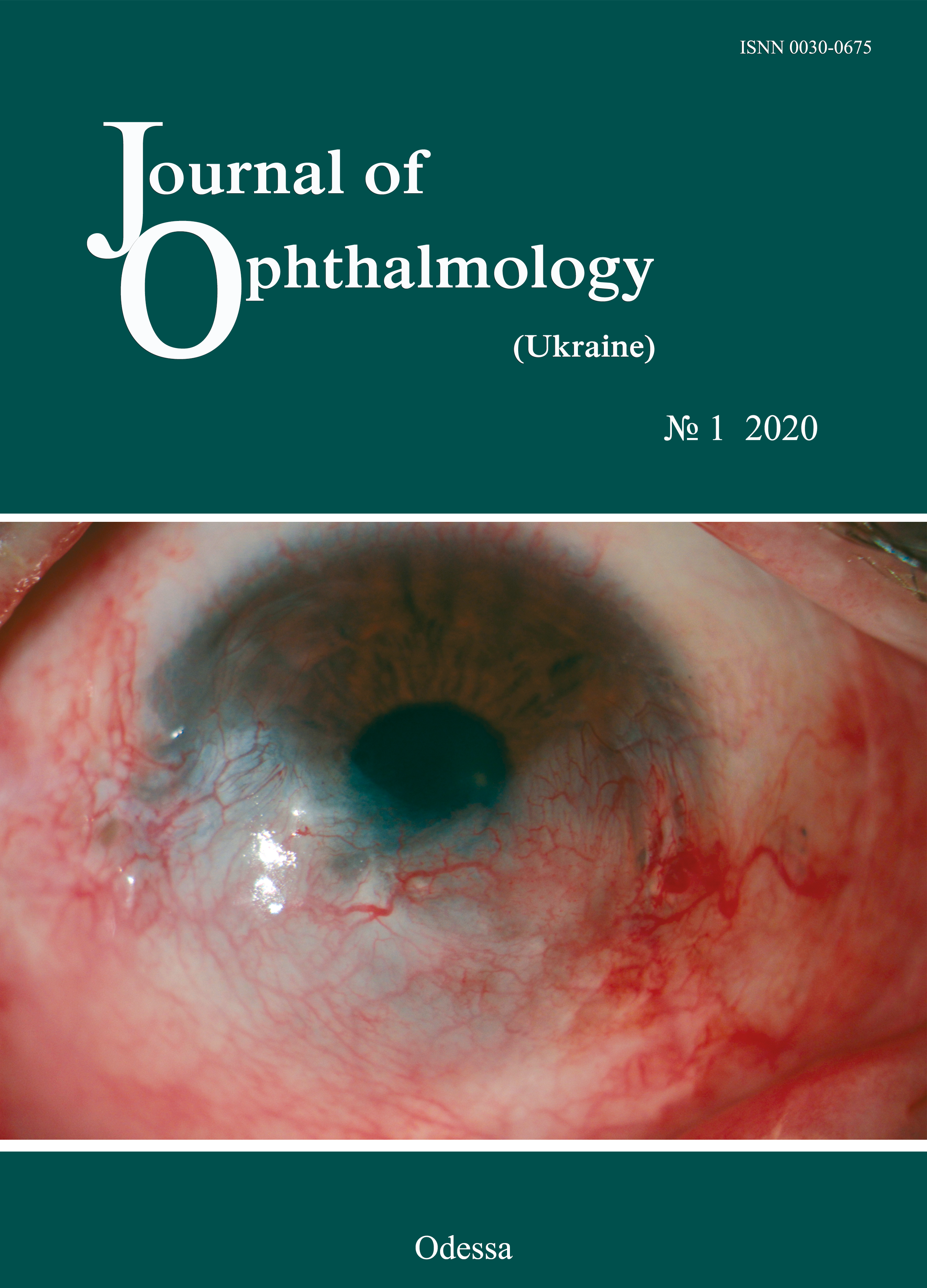Ocular heat exchange indices in terminal neovascular glaucoma patients with proliferative diabetic retinopathy
DOI:
https://doi.org/10.31288/oftalmolzh202011013Keywords:
temperature of the external ocular surface, heat flow density, rheoophthalmography, diabetic retinopathy, terminal neovascular glaucomaAbstract
Background: The heat processes in patients with diabetes mellitus are still poorly understood.
Purpose: To examine temperature of and heat flow (HF) density from the ocular surface in the eyes of patients with neovascular glaucoma that had developed in the presence of proliferative diabetic retinopathy (PDR).
Material and Methods: In this open pilot study, 25 patients (50 eyes) with PDR in both eyes were under observation. In each patient, one eye was diagnosed with terminal neovascular glaucoma, and received laser treatment that included three sessions of transscleral contact-compression laser cyclocoagulation (TSCC LC). Before and 1 month after laser treatment, patients underwent examinations in both eyes as follows: best-corrected visual acuity testing, intraocular pressure (IOP) measurements, and measurements of temperature of the external corneal surface and HF density from the eye.
Results: Before laser treatment, mean corneal surface temperature and mean HF density from the eye in glaucomatous eyes were 33.9 ± 0.9°С and 5.8 ± 1.6 mW/cm2, respectively, and were lower than in the fellow eyes (34.4 ± 1.0°С (p = 0.08) and 6.9 ± 1.4 mW/cm2 (p = 0.02), respectively). At 1 month after laser treatment, in glaucomatous eyes, mean IOP decreased from 36.3±5.4 mmHg to 25.8±4.6 mmHg (p =0.000), mean corneal surface temperature increased to 34.5 ± 0.9°С (p = 0.06), and mean HF density from the eye increased to 8.3±1.99 mW/cm2 (p =0.000).
Conclusion: In patients with terminal neovascular glaucoma in one eye only, there was an asymmetry in ocular heat exchange indices between glaucomatous eyes and fellow eyes (with normal IOP). In addition, an increase in HF density from the eye in the presence of decreased IOP in eyes with terminal neovascular glaucoma after transscleral contact-compression laser cyclocoagulation seems to result from an increased intraocular thermal gradient in the presence of improved ocular hemodynamics.
References
1.Savvin VN, Korotkova OL, Shishkin GP. [Use of thermodynamic approaches in assessment of the state of living systems]. Viatskii meditsinskii vestnik. 2017; 2:40-44. Russian.
2.Lucia U. Bioengineering thermodynamics of biological cells. Theor Biol Med Model. 2015 Dec 1;12:29. https://doi.org/10.1186/s12976-015-0024-z
3.Kudinov VA, Kartashov EM, Stefaniuk EV. [Technical thermodynamics and heat transfer]. Textbook for Academic Baccalaureate. Мoscow: Iurait; 2019. Russian.
4.Schwartz B, Feller MR. Temperature gradients in the rabbit eye. Invest Ophthalmol. 1962 Aug;1:513-21.
5.Anatychuk LI, Pasyechnikova NV, Naumenko VА, Zadorozhnyy OS, Gavrilyuk MV, Kobylianskyi R.R. A thermoelectric device for ophthalmic heat flux density measurements: results of piloting in healthy individuals. J Ophthalmol (Ukraine). 2019; 3:45-51.https://doi.org/10.31288/oftalmolzh201934551
6.Anatychuk LI, Pasyechnikova NV, Naumenko VА, Zadorozhnyy OS, Hramenko NI, Kobylianskyi RR. Temperature of and heat flux density from the external ocular surface in diabetic retinopathy patients: a pilot study. J Ophthalmol (Ukraine). 2019; 6:3-5.
7.Kenny GP, Sigal RJ, McGinn R. Body temperature regulation in diabetes. Temperature. 2016;3(1):119-45.https://doi.org/10.1080/23328940.2015.1131506
8.Chechin PP, Guzun OV, Khramenko NI, Peretyagin OA. Efficacy of transscleral Nd:YAG laser cyclophotocoagulation and changes in blood circulation in the eye of patients with absolute glaucoma. J Ophthalmol (Ukraine). 2018; 2:34-9.https://doi.org/10.31288/oftalmolzh/2018/2/34-39
9.Auker CR, Parver LM, Doyle S, et al. Choroidal blood flow. I. Ocular tissue temperature as a measure of flow. Arch Ophthalmol. 1982; 100:1323-6.https://doi.org/10.1001/archopht.1982.01030040301020
10.Konieczka K, Koch S, Hauenstein D, et al. Effects of the glaucoma drugs latanoprost and brimonidine on corneal temperature. Trans Vis Sci Tech. 2019 May; 8(3): 47. https://doi.org/10.1167/tvst.8.3.47
11.Zadorozhnyy OS, Guzun OV, Bratishko AIu, Kustrin TB, Nasinnik IO, Korol AR. Infrared thermography of external ocular surface in patients with absolute glaucoma in transscleral cyclophotocoagulation: a pilot study. J Ophthalmol (Ukraine). 2018; 2:23-2.https://doi.org/10.31288/oftalmolzh/2018/2/2328
12.Galassi F, Giambene B, Corvi A, et al. Retrobulbar hemodynamics and corneal surface temperature in glaucoma surgery. Int Ophthalmol. 2008 Dec;28(6):399-405.https://doi.org/10.1007/s10792-007-9160-8
Downloads
Published
How to Cite
Issue
Section
License
Copyright (c) 2025 О. С. Задорожный, О. В. Гузун, Т. Б. Кустрин, А. Р. Король, В. А. Науменко, Н. В. Пасечникова

This work is licensed under a Creative Commons Attribution 4.0 International License.
This work is licensed under a Creative Commons Attribution 4.0 International (CC BY 4.0) that allows users to read, download, copy, distribute, print, search, or link to the full texts of the articles, or use them for any other lawful purpose, without asking prior permission from the publisher or the author as long as they cite the source.
COPYRIGHT NOTICE
Authors who publish in this journal agree to the following terms:
- Authors hold copyright immediately after publication of their works and retain publishing rights without any restrictions.
- The copyright commencement date complies the publication date of the issue, where the article is included in.
DEPOSIT POLICY
- Authors are permitted and encouraged to post their work online (e.g., in institutional repositories or on their website) during the editorial process, as it can lead to productive exchanges, as well as earlier and greater citation of published work.
- Authors are able to enter into separate, additional contractual arrangements for the non-exclusive distribution of the journal's published version of the work with an acknowledgement of its initial publication in this journal.
- Post-print (post-refereeing manuscript version) and publisher's PDF-version self-archiving is allowed.
- Archiving the pre-print (pre-refereeing manuscript version) not allowed.












